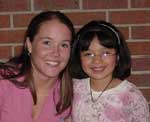
May - June 2003
Vol. 14, No. 3 | Contents
|
RB: People |
Passings: Anne Hilecher & Keith Karney | |
| Athletes of the Year | ||
| Racquet for the Cure, No.4 | ||
| Camping Out, Elite-Style | ||
| Journeyman Players | ||
| UNC Club Bash |
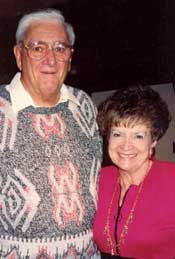 Anne Hilecher
Anne Hilecher
On January 29th, 2003, Anne Hilecher died of stomach cancer. For any professional player from the days of Charley Brumfield to Cliff Swain, Anne served as an honorary MOM. She loved racquetball and going to tournaments. During the 70’s and much of the 80’s, many participants would see her at tournaments, getting players drinks, and selling her little racquetball necklaces. [She is pictured, above, with husband Daniel, in 1993.]
From the first National Championship held in St. Louis in 1969, Anne committed her time and efforts in providing hospitality as well as her caring and love. Players from out of town were always welcome to stay at her home and one year, she even invited Steve Strandemo to her party, the night she beat her son in the finals of a St. Louis Pro tournament.
I am sure that I can speak for any professional player that has ever met her, seen her enthusiasm, passion and love for the sport and other people, that she will surely be missed. —
Jerry Hilecher
Anne is survived by her husband Daniel, daugher Robin Pevnick, and sons Alan and Jerry Hilecher. Condolences to Daniel and family can be sent by phone to 561-479-1045, or by email to
jhilecher@gatewaytelnet.com.
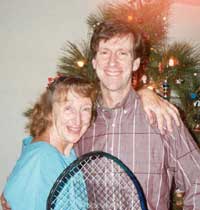 Keith Karney
Keith Karney
On November 21, 2002, Keith Karney succumbed to melanoma in a Sierra Nevada
hospital, leaving behind a grief-stricken family, and staggering medical bills.
He is pictured, two years ago, with his mother Elaine, who wrote “He took your magazine for quite awhile, I believe. He played in all the tournaments and usually won. He had lots of trophies; he lived for racquetball. We miss him so.”
Condolences/assistance to: Stan & Elaine Karney, 15123 Garcal Drive, San Jose, CA 95127-2612.
Top
The USRA recently named the recipients of the 2002 Athlete of the Year awards, to be honored at the annual awards banquet in Houston, Texas on May 24. Also featured at the banquet will be
Hall of Fame inductee Cliff Swain.
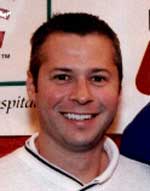 Mike Guidry |
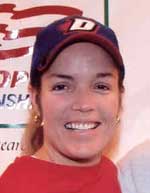 Cheryl Gudinas |
Male Athlete of the Year: Mike Guidry (Carrollton, Texas) After ousting defending champion Jack Huczek in the finals of the USRA National Singles last May, Mike Guidry paired up with long-time doubles partner Ruben Gonzalez to repeat as the USRA National Doubles Champions in October. With the wins, Guidry became only the fourth player to win both the USRA National Singles Championships and the USRA National Doubles Championship in the same year.
Guidry also competed for the U.S. National Team that earned back the IRF World Cup in August. Guidry teamed with Gonzalez earning third place at the event in doubles competition. The two also teamed together to earn gold medals at the PARC Tournament of the Americas, helping the U.S. to take home the men’s and overall team trophies.
“Earning this award is something that I have always wanted,” said Guidry. “It’s a real honor and a dream come true.”
Female Athlete of the Year: Cheryl Gudinas (Lisle, Illinois) Cheryl Gudinas won her fourth straight USRA National Singles Championship in 2002, defeating Laura Fenton in the final. Gudinas also did not lose a single game enroute to her second straight IRF World Singles Championship, aiding the U.S. in bringing home the women’s and overall team championships.
In addition to playing for her country, Gudinas served as an assistant coach on the U.S. Junior National Team and for the USRA Elite Training Camp. She is also the top ranked player on the LPRA Tour and the current U.S. OPEN singles champion.
“It’s always a great honor and I enjoy getting the award,” Gudinas said. “Not because it reminds me of what I have been so fortunate to accomplish, but because it gives me the opportunity to thank those that have made my accomplishments possible.”
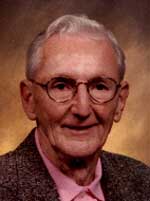 Bob McAdam |
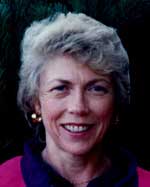 Sharon Hastings-Welty |
Bud Muehleisen Award [Male Age Group]: Robert McAdam (Crowley, Texas) Robert
McAdam, 82, took up racquetball at the age of 53 and has been winning national and international titles ever since. In 2002 he earned titles at the NMRA National Championships, the NMRA International Invitational Championships, and the USRA National Singles Championships – all in the men’s 80-and-over divisions. He placed second at the IRF World Seniors Championships in the same division.
He was very humble after learning of his selection. “I have learned that the racquetball group, especially the old guys, is a great fraternity,” McAdam said. “I am just in awe to be playing with legends and to be able to beat them every once in awhile.”
Peggy Steding Award [Female Age Group]: Sharon Hastings-Welty (Corvallis, Oregon) This is the second time that Sharon
Hastings-Welty, 62, has earned the Peggy Steding Award; her first was in 1998. In 2002 she dominated her age groups winning titles in women’s 60-and-over at the NMRA National Championships, the Women’s Senior Master Championships, the IRF World Seniors Championships, the Choice Hotels U.S. OPEN Racquetball Championships, and the USRA National Singles Championships. At the U.S. OPEN,
Hastings-Welty also won the women’s 55-and over division.
Upon hearing the news, Hastings-Welty was pleasantly surprised. “I’m stunned and pleased and overwhelmed,” she said. “I am very excited and it’s very nice.”
the Cure
by Jean Gallagher
Top
Pictured L-R:
Kristen Walsh, Jean Gallagher, Jackie Rice
Photo: Chip Sampsel
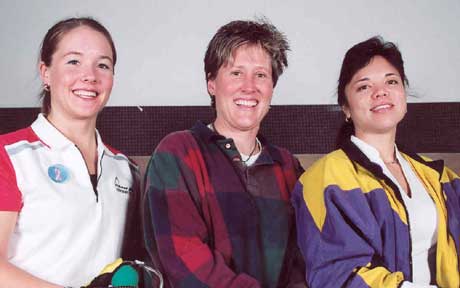 In it's fourth annual "running", Denver’s annual Racquet for the Cure Tournament
once again topped the charts for participation by offering a fun-packed, full day of intense team play.
In it's fourth annual "running", Denver’s annual Racquet for the Cure Tournament
once again topped the charts for participation by offering a fun-packed, full day of intense team play. With this year’s goal set at raising $5000 for the Susan G. Komen Foundation, a great deal of credit goes to all the sponsors and players for making this event the most successful to date. A new mixed doubles round, plus other fundraising events, special donations and involvement by Colorado women, all combined to help us reach our goal.
We kicked off with mixed doubles on Friday night, which drew 30 teams that played 20 minute round robins at all levels. The energy that filled the Lakewood Athletic Club was irrefutable, and I’d never seen so much excitement over competition. Some of the players had never even met before being teamed up that night.
 Our featured LPRA guests this year were Jackie Paraiso-Rice and Kristin Walsh [shown
L-R, at right>], who headlined the “Play with the Pro” fundraiser during the mixed doubles event. In some cases (mostly among the men) it was a play
against the pro. Between munching on pizza and enjoying the entertainment, lots of oohs and aahs came from the crowd, as both new and experienced players stepped onto the court to face the pros. Jackie and Kristin relaxed into the atmosphere and played to their usual high-level, left-
or right-handed. Throughout the expanded Friday format, new friendships were formed along with a more complete understanding about the Racquet for the Cure tournament itself. Special thanks go out to both Jackie and Kristin, and also to “the guys” for bringing even more enthusiasm to the project.
Our featured LPRA guests this year were Jackie Paraiso-Rice and Kristin Walsh [shown
L-R, at right>], who headlined the “Play with the Pro” fundraiser during the mixed doubles event. In some cases (mostly among the men) it was a play
against the pro. Between munching on pizza and enjoying the entertainment, lots of oohs and aahs came from the crowd, as both new and experienced players stepped onto the court to face the pros. Jackie and Kristin relaxed into the atmosphere and played to their usual high-level, left-
or right-handed. Throughout the expanded Friday format, new friendships were formed along with a more complete understanding about the Racquet for the Cure tournament itself. Special thanks go out to both Jackie and Kristin, and also to “the guys” for bringing even more enthusiasm to the project.|
|
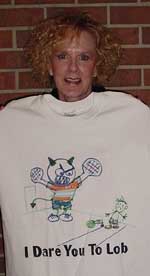 |
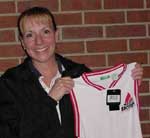 |
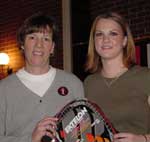 |
On Saturday, the largest women’s tournament held in the state of Colorado opened with 54 women checking in to challenge their way to the top of their divisions. For those who didn’t reach the top, just when you thought you’d be done (after already losing two matches), you’d find your name in the consolation, of the consolation, for the losers’ bracket! It was insane, and more racquetball than anyone can expect to encounter in a single day. But we were inspired after watching Jackie and Kristin challenge each other in four games while – from the sidelines — local pro Jo Shattuck led the traditional “wave” every time one of the ladies dove for a ball. That type of crowd involvement only brings out the best in the players on the court, and once they were done, they didn’t even stop for a break before offering clinics to separate groups of ten eager students each. We all look forward to following the rest of the LPRA season, after meeting these top pros “up close and personal.”
The banquet forced players to drag their exhausted bodies away from the club to a catered meal, and even though the beer cart didn’t fit through the doors, we still managed to fight the cold to donate a bit more money to the cause. Every player was given a chance to choose their own prize from the awards table, which was loaded with over a dozen top-of-the-line frames, bags, shirts, gloves and
eyeguards, not to mention signature items sent by the LPRA players. Our guest speaker, from the Denver-based Susan G. Komen Foundation affiliate, shared how the money raised from the event would be best utilized. Our event, which we are trying to expand to a national level, will continue to support breast cancer research and also help those in medical need. Thanks to our largest corporate partner, Wilson Sports, money for this effort is now being raised in 13 different cities through a variety of one- and two-day events. So far this season, our grand reported total for the Foundation has been over $15,000!
Each year, as we begin planning the “Racquet for the Cure” tournament, our goals get higher and higher. At the inaugural 1999 event we raised $200, then tripled it the following year with $600 in 2000. Last year we achieved a five-fold jump to $3000 and this year, with a generous “over the top” contribution by Howard and Theresa Tilton, we were able to hit our latest goal of $5000. In all, the fourth annual event was the best yet!
Our goals for next year will be even higher, and with the type of encouragement and support we’ve enjoyed from sponsors, supporters, players and friends, we’re certain to reach those new goals as well. See you in 2004!
by Ryan John
Top
Now, 20 years later, the camp is still going strong, despite a series of interesting changes. The AARA is now the USRA, the camp has been renamed the High Performance Camp, and Cheryl Gudinas is now one of its instructors. Oh, and the camp might have helped her a bit, because she’s won a couple of tournaments since her first elite training camp.
I learned of the camp in the first few months of my employment at the USRA. “Are you writing a press release on the Elite Camp?” Jim Hiser asked me one day after I wandered into his office. “Sure,” I replied. “What is it?”
After his explanation, I thought the camp sounded like a great idea. I wasn’t sure if I was a promising racquetball player, but I was sure that I wanted to bring my game up a level, or two … or ten. After some creative wheedling to Hiser (who leads the camp), and pitching a story for the magazine, it was agreed that I would become an official camper.
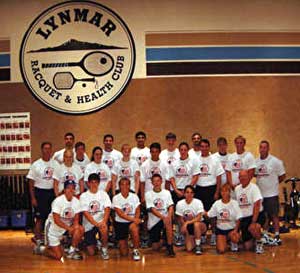 Camp participants are housed at the Olympic Training Center, right alongside Olympic athletes, and each day starts with a morning run to, and around, Memorial Lake. This three-mile wake-me-up, ends at the tennis courts for morning exercises and drills. As everyone is still trying to catch their breath in the high altitude, Hiser smiles menacingly as he leads the group through stretches, sit-ups, and push-ups. This is followed with more conditioning and footwork drills. Just when you think that you aren’t able to go any further it’s time for the run back to the training center to grab a quick bite.
Camp participants are housed at the Olympic Training Center, right alongside Olympic athletes, and each day starts with a morning run to, and around, Memorial Lake. This three-mile wake-me-up, ends at the tennis courts for morning exercises and drills. As everyone is still trying to catch their breath in the high altitude, Hiser smiles menacingly as he leads the group through stretches, sit-ups, and push-ups. This is followed with more conditioning and footwork drills. Just when you think that you aren’t able to go any further it’s time for the run back to the training center to grab a quick bite.After wolfing down breakfast, we’re loaded on a bus to the Lynmar Racquet & Health Club, the official USRA training facility. Each day players are instructed on stroke mechanics, court positioning, serves, and footwork. After each lesson the group is then split into smaller groups for closer supervision while they practice and drill what was just learned.
Videotaping is a big part of the camp, and U.S. Team Head Coach Jim Winterton scheduled players throughout each day to be recorded and analyzed. I was surprised the first time I saw my strokes on tape and realized I needed a lot of work. Winterton reaffirmed this a bit too willingly, but assured me that we would get it worked out.
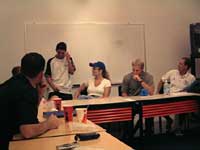 After finishing up at Lynmar, the group is bussed back to the training center for dinner, followed by group meetings. The mental aspect of the game is discussed at great length during these meetings. In this camp,
Winterton, Hiser, Gudinas, U.S. Junior Team Coach Kelley Beane, BYU National Champion Head Coach Dennis Fisher, and former World Junior Champion Josh Tucker all shared their views on the game. They discussed everything from strategy, to how to train, to what to eat. I couldn’t imagine a more knowledgeable group of racquetball experts, all sharing their secrets. You could sense the room was hanging on their every word.
After finishing up at Lynmar, the group is bussed back to the training center for dinner, followed by group meetings. The mental aspect of the game is discussed at great length during these meetings. In this camp,
Winterton, Hiser, Gudinas, U.S. Junior Team Coach Kelley Beane, BYU National Champion Head Coach Dennis Fisher, and former World Junior Champion Josh Tucker all shared their views on the game. They discussed everything from strategy, to how to train, to what to eat. I couldn’t imagine a more knowledgeable group of racquetball experts, all sharing their secrets. You could sense the room was hanging on their every word.
After nearly a full week of training the camp was nearing an end, but it wasn’t quite finished yet. On the last day there was no morning run scheduled. In its place was something called a “simulated run.” I wasn’t quite sure what that was, or could be, but I soon found out. We met at the cinder track of a local school instead of Memorial Park. Hiser was there with his usual morning smile and a whistle.
I learned that the simulated run was an idea based on replicating how the body is affected during a racquetball match. Hiser would blow the whistle and everyone had to begin sprinting as hard as they could around the track. When he blew the whistle a second time everyone could slow down to a jog. He then blew it again and it was back to sprinting. This went on for 20 minutes with some sprints longer than others. At the end of 20 minutes we got a two-minute break — the same amount of time allotted between games in a match. At the end of the two minutes it was back to the track for another session. Before the run began we were told that if anyone slacked off, then everyone would be forced to go to a “tiebreaker.” Luckily nobody slacked off during the run, and I think Hiser and Winterton were a little disappointed that didn’t get to watch us run around for another 20 minutes.
The camp ended with a tournament at Lynmar. Although everyone was drained from the week (and the simulated run in particular) you could easily see the strides made in their games. It was even becoming evident that some of the players in the camp were going to earn some tournament buzz. One of the sessions campers, Paige Harris, recently won the girl’s No.2 singles division at the USRA Intercollegiate Championships.
I have now participated in the camp for two years and would do it again in a heartbeat. It is by no means a walk in the park; nothing worthwhile ever is. It’s demanding, both physically and mentally, but everyone that has ever completed one has come away a better player. If improving your racquetball game is a priority for you,
signing up for this year’s camp is a definite must. [more
info]
by Amos Rosenbloom
Top
Minneapolis will host the National Masters Racquetball Tournament this July 23-26 at the Northwest Hiway 100 Club. Although this event challenges the best over-45 players in the country, it also attracts those who play for the “health of it.” Preparing through practice and conditioning, this “workout” helps body and soul, and sharing tournament camaraderie maintains social contacts that are precious. Ten seconds of “Hello, how are
ya!?” and a pat on the back go along way in maintaining mental health. There isn’t a player in the 70’s, and older, who doesn’t have a medical history.
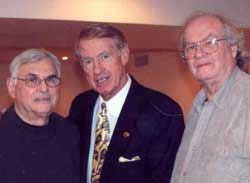 Snapped at the Minnesota Racquetball Hall of Fame banquet are three players who will play the July Masters in the 70+ bracket. Shown left to right
are: Amos
Rosenbloom, Minneapolis, Minnesota, 75 (arthritis, hip replaced, cancer survivor); Bob McNamara, Edina, Minnesota, 71 (arthritis, both knees, one shoulder and one hip replaced); and John
Lafond, St. Paul, Minnesota, 74 (arthritis). None of them get extra sympathy points when they play, since their opponents have their own story.
Snapped at the Minnesota Racquetball Hall of Fame banquet are three players who will play the July Masters in the 70+ bracket. Shown left to right
are: Amos
Rosenbloom, Minneapolis, Minnesota, 75 (arthritis, hip replaced, cancer survivor); Bob McNamara, Edina, Minnesota, 71 (arthritis, both knees, one shoulder and one hip replaced); and John
Lafond, St. Paul, Minnesota, 74 (arthritis). None of them get extra sympathy points when they play, since their opponents have their own story.
Unlike most, NMRA tournaments are strictly round robin, so players are never “out.” Everyone continues to earn points for each match and are then re-positioned within their age bracket by total points when all is said and done. Fifteen midwest players have already indicated that they intend to play, and we’ve set a goal of having the largest 70’s draw ever.
In fact, all of these 70+ players have already indicated that they are going to be on hand: Cap
Hiles, Panama City, FL; John Brandrup, Rochester, MN; Ivan Bruner, Madison, WI; Dick
Wadewitz, Platteville, WI; Tim Rusch, Eden Prairie, MN; Lyle Schumacher, Winona, MN; Charlie Schafer, Pella, IA; Ray Gordon, Grand Forks, ND; Ralph
Stillman, Deephaven, MN; Bob Englund, Minneapolis, MN; Max Fallak, Minneapolis, MN; Norm
Goldetsky, Minnetonka, MN; Royal Slack, Panama City Beach, FL.
It is our hope that many more players will choose to attend this summer tournament and encourage others to sign up, too. For more information, go to
www.nmra.info or contact Ron Pudduck
(phone: 734-425-7522).
Journeymen Players … are focused on encouraging a record number of 70-year-old players to attend the NMRA tournament at the Northwest Highway 100 Club in Minneapolis July 23-26. Journeymen Players recognize that winning at 70 means signing up and getting into condition to play, then enjoying the camaraderie that maintains mental health and keeps body and soul together.
In support of these efforts, Journeymen Players have made a limited number of expense scholarships that include a public relations package to players 70 or older. Past recipients have been Verlyn Dunn of Pocatello, Idaho, “Cap” Hiles of Stillwater, Minnesota, and Amos Rosenbloom of Edina, Minnesota.
For more information contact: Journeymen Players, C/O Amos Rosenbloom, 5810 West 78th Street, Bloomington, MN 55439.
by Lynn Stephens
Top
On the weekend of February 14, the Southeastern Intercollegiate Regional, better known as the “UNC Club Bash” was held on the campus of the University of North Carolina at Chapel Hill. Students from seven universities in North Carolina and Virginia competed for individual and overall team titles, representing
UNC, UNC-Greensboro, UNC-Charlotte, Duke, NC State, Virginia Tech, and William and Mary.
Singles and doubles were played in the Olympic format, and the event served as a fundraiser to assist the UNC racquetball club in attending the National Intercollegiate Championships in April. The individual championship was won by Ben Coit (Virginia Tech) in a tough two gamer over Zach Archer (Duke). Virginia Tech also won the team championship, with UNC second, and Duke coming in third.
With bad weather expected to reach the area Saturday night, Curt decided that — with the students’
cooperation — the entire tournament could be completed on Saturday, thus allowing the students that had to travel to leave early. The students agreed to play back-to-back, to-back matches if necessary. So instead of a noon Sunday finish, all matches were completed and awards handed out by Saturday at 6:30 PM. Needless to say, the students got plenty of court time on Saturday … but no one complained, and everyone enjoyed the competition and school rivalry.
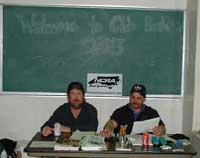 The NCRA helped support the event by running the tournament desk. In charge of tournament control was the NCRA’s Youth Program Director, Curt “Spazz” Smith (far
left), assisted by Membership Director Mike “Bush Hog” Bourgeois (near
left) and NCRA President Lynn “the
prez” Stephens. Added support came from the Daly Seven Corp., Syntech Signs and E-Force, via the
NCRA, which is dedicated to supporting collegiate players with the aim of creating lifelong enthusiasts.
The NCRA helped support the event by running the tournament desk. In charge of tournament control was the NCRA’s Youth Program Director, Curt “Spazz” Smith (far
left), assisted by Membership Director Mike “Bush Hog” Bourgeois (near
left) and NCRA President Lynn “the
prez” Stephens. Added support came from the Daly Seven Corp., Syntech Signs and E-Force, via the
NCRA, which is dedicated to supporting collegiate players with the aim of creating lifelong enthusiasts.
Top | RacquetballMagazine.com | USRA.org
© United States Racquetball Association -- All Rights Reserved
